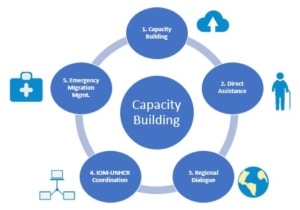Improving Refugee Assistance: SI’s Evaluation of Horn of Africa and Mesoamerican Programs
For the last decade, SI has conducted a series of evaluations for the U.S. Department of State Bureau of Population, Refugees, and Migration (DoS/PRM) that has built an evidence base about what works, and what can be improved upon in refugee assistance. These evaluations, across various refugee populations and continents, underscore the need for continued funding for refugee programming. One such evaluation was conducted to assess the effectiveness of regional migration programs in providing assistance to vulnerable migrants. The programming managed by the DoS/PRM was implemented by the International Organization of Migration (IOM) in five Horn of Africa countries, and seven Mesoamerican countries. SI’s evaluation was designed to identify program strengths including best practices, and areas for improvement to inform future DoS/PRM programming.
SI’s Evaluation
SI’s evaluation was driven by two main questions: what is the program’s ability to build government capacity to address migrants’ needs, and how does the programming contribute to strategic regional responses for vulnerable migrants? To answer these questions, SI’s team examined PRM-IOM’s five-pillar approach to Regional Migration Programs (RMPs), which was a model designed to build sustainable government capacity to manage migration for their 10 RMPs at the time. The pillars included capacity building, direct assistance to vulnerable migrants, links to regional migration dialogues, IOM-United Nations High Commissioner for Refugees coordination, and emergency migration management. In particular, the evaluation examined the five-pillar approach’s relevance, appropriateness, and whether and how the model should be refined in the future.

PRM-IOM’s Five Pillar Approach
SI’s evaluation utilized qualitative and quantitative methods, beginning with a thorough document review of project materials and key literature. The team then conducted primary data collection in Kenya, Djibouti, Ethiopia, Costa Rica, Guatemala, and Mexico through nearly 300 interviews. SI’s team additionally captured survey data from IOM staff across several regions and programs.
Conclusions and Recommendations
SI’s evaluation discovered that RMPs led to increases in government officials’ and others’ knowledge of migration and vulnerability and made positive changes in their attitudes towards migrants. In addition to these advances, SI suggested further training for IOM officials, given responses citing additional support being needed for migrant screening practices and assisting sexual violence victims. Despite significant practical and political challenges, IOM has incrementally improved regional understandings of and approaches to migration. IOM’s support for regional cooperation structures was exemplary in both regions. To improve upon the existing capacity building practices across the regions, SI suggested the use of clear strategies and greater alignment with international best practices.
The evaluation team provided several overarching recommendations including simplifying IOM activities to focus on those most likely to build government capacity, integrating systematic approaches to monitoring and evaluating activities, and broadening partnerships to build greater capacity. SI’s findings and recommendations prompted DoS/PRM to alter its programming to both improve conditions for migrants and increase the long-term sustainability of the assistance.








